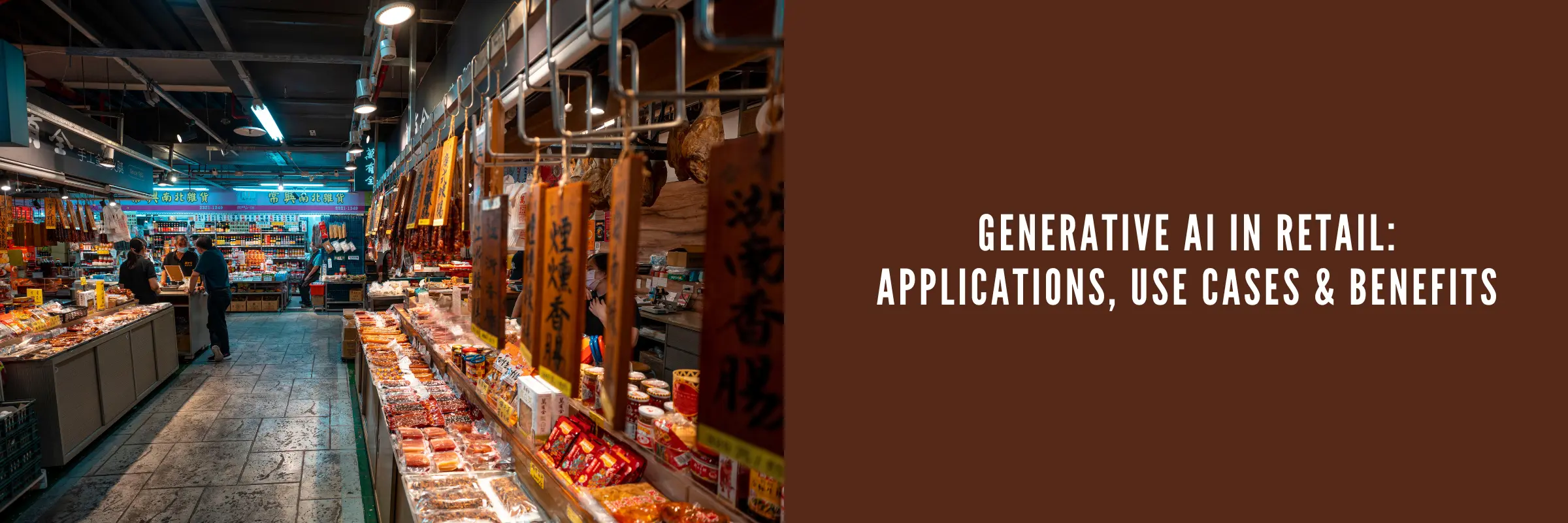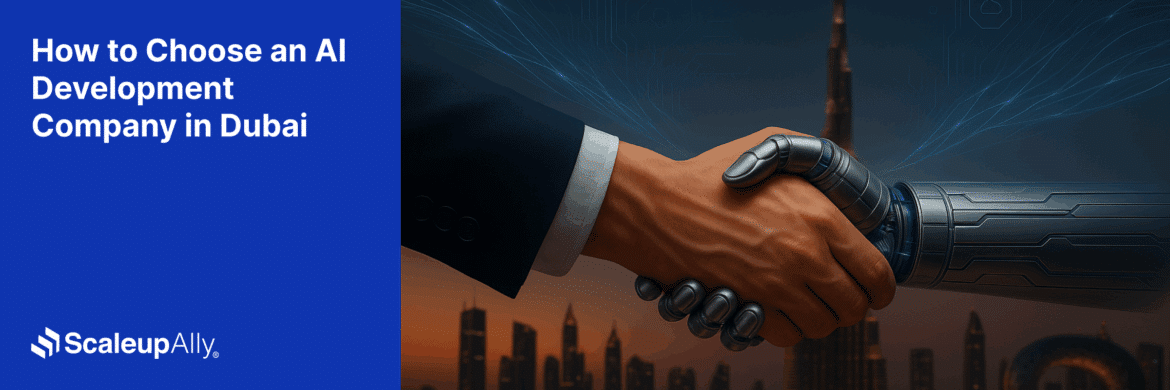
Generative AI in Retail: Applications, Use Cases & Benefits
Manu Jain | February 29, 2024 , 11 min read
Table Of Content
Have you ever wandered through a mall searching for a store without checking the directory? That confusion is similar to navigating AI without guidance.
Most people know about generative AI and chatbots like ChatGPT, but its real applications in retail and eCommerce—across marketing, support, operations, learning, and product management—are often less clear.
Generative AI can accelerate growth, boost productivity, ensure compliance, and transform the retail customer experience.
In this guide, we’ll explore the key applications, use cases, and benefits of generative AI in retail, helping professionals identify the right opportunities to support their goals.
Key Takeaways
- Generative AI enhances visual merchandising by creating personalized, data-driven displays that resonate with customers.
- AI-powered customer service automation reduces wait times and operational workload while delivering instant, accurate assistance.
- Product design and development are accelerated as generative AI generates innovative concepts tailored to customer preferences.
- Virtual try-on solutions enable customers to visualize products realistically, improving confidence and reducing returns.
- Dynamic pricing optimization leverages AI to adjust prices based on demand, competition, and market trends for maximum profitability.
- AI-driven security and loss prevention tools monitor retail spaces in real time, ensuring safer and more efficient operations.
What is Generative AI in Retail?
- What is Generative AI in Retail?
- Benefits of Generative AI in Retail
- Key Applications of Generative AI in Retail
- How generative AI is used in retail?
- Challenges of Generative AI in the Retail Industry
- Case Study: Generative AI in Retail Business
- Conclusion
- Frequently Asked Questions (FAQs)
- Similar Articles Around Generative AI
Generative AI in retail refers to the use of artificial intelligence techniques, such as generative adversarial networks (GANs) or other generative models, to create or generate new content, designs, or solutions in the retail industry. This technology can be used in various ways to enhance the retail experience for customers and businesses.
Benefits of Generative AI in Retail
Generative AI offers several benefits to the retail industry. Here are a few:
1. Visual Merchandising
Generative AI can analyze customer behavior and preferences to create visually appealing in-store displays and online storefronts. Example: A furniture retailer uses generative AI to analyze customer preferences for furniture styles and colors. Based on this analysis, the AI creates virtual room displays that showcase furniture pieces in a way that resonates with customers, increasing the likelihood of a purchase.
2. Customer Service Automation
An electronics retailer could use generative AI to power a chatbot on its website. The chatbot can answer common customer queries about products and policies, providing instant assistance to customers and reducing the workload on human customer service agents. Generative AI can automate customer service tasks, such as answering queries and processing returns, reducing wait times and improving efficiency.
3. Product Design and Development
Generative AI can aid in product design and development by generating new design concepts and iterating on existing ones based on customer feedback. For instance, a shoe retailer can use generative AI to create fresh shoe styles that are likely to appeal to customers. By taking into account customer feedback on existing designs, the AI can generate new, more attractive designs that can reduce the time and cost of product development.
Key Applications of Generative AI in Retail
Generative AI is used in several ways within the retail industry, such as:
1. Virtual Try-On
By using Generative AI to create realistic virtual try-on experiences, retailers can help customers visualize how products will look before making a purchase. For example, an eyewear retailer can offer a virtual try-on tool that uses AI to simulate how different glass frames will look on a customer’s face, helping them make more confident buying decisions.
2. Dynamic Pricing Optimization
Generative AI can analyze various factors such as demand, competitor pricing, and market trends to optimize pricing strategies in real time. A retailer can use AI to adjust prices dynamically based on factors like inventory levels and customer behavior, maximizing profits while remaining competitive.
3. Interactive Customer Service
Chatbots powered by Generative AI can provide personalized assistance to customers, answering queries, offering product recommendations, and resolving issues. For example, a retailer can use AI-powered chatbots to provide real-time assistance to customers on its website, enhancing the overall shopping experience.
4. Loss Prevention and Security
Generative AI can analyze security footage to detect suspicious behavior, helping retailers prevent theft and ensure a safe shopping environment. A retailer can use AI to identify unusual patterns in store traffic or monitor for shoplifting behavior, enabling timely intervention by security personnel.
Curious How AI Transforms Retail?
Explore how generative AI enhances customer experiences and streamlines operations in retail.

How generative AI is used in retail?
1. Personalized Shopping Experiences
Retailers use generative AI to analyze customer data and create personalized recommendations. Imagine a clothing retailer can use AI to suggest outfits based on a customer’s style preferences and previous purchases, similar to a personal stylist.
2. Inventory Management
AI algorithms can predict product demand and optimize inventory levels. Grocery stores can use generative AI to forecast demand for certain products based on weather patterns and local events, ensuring shelves are always stocked with the right items.
3. Visual Search
Generative AI enables visual search capabilities, allowing customers to search for products using images rather than text. For example, a furniture retailer can use AI to allow customers to upload a picture of a room and then recommend furniture pieces that match the style and color scheme.
Challenges of Generative AI in the Retail Industry
1. Data Quality and Quantity
Generative AI models require large amounts of high-quality data to generate accurate and useful outputs. Retailers may struggle to collect and manage the volume and quality of data required for effective generative AI applications.
2. Ethical Considerations
The use of generative AI in retail raises ethical concerns, such as privacy issues related to the collection and use of customer data and potential biases in the AI algorithms that could lead to discriminatory outcomes.
3. Interpretability
Generative AI models can produce complex and abstract outputs that are difficult to interpret or explain. This lack of interpretability can make it challenging for retailers to trust the outputs of these models and integrate them into decision-making processes.
4. Integration with Existing Systems
Integrating generative AI into existing retail systems and processes can be complex and challenging. Retailers may need to update or replace existing systems to accommodate generative AI applications, which can be costly and time-consuming.
5. Regulatory Compliance
The use of generative AI in retail may be subject to regulatory requirements, such as data protection laws and consumer protection regulations. Retailers must ensure compliance with these regulations when deploying generative AI applications.
6. Security Concerns
Generative AI models, like all AI systems, can be vulnerable to attacks and manipulation. Retailers must ensure the security of their generative AI systems to protect against potential threats.
7. Skill and Knowledge Gap
Implementing and managing generative AI systems in retail requires specialized skills and knowledge. Retailers may struggle to find and retain personnel with the necessary expertise to deploy and maintain generative AI applications effectively.
Case Study: Generative AI in Retail Business
Here are some examples of retail businesses that are using Generative AI:
1. North Face
The North Face, a leading outdoor apparel and equipment retailer, implemented generative AI to enhance its product recommendations. The company uses AI algorithms to analyze customer data, including browsing behaviour and purchase history, to generate personalized product recommendations. This has helped North Face improve customer engagement and increase sales by offering customers products that align with their preferences and interests.
2. Sephora
Sephora, a multinational chain of beauty stores, uses generative AI to offer virtual try-on experiences for customers. Sephora’s Virtual Artist feature allows customers to try on different makeup products virtually using their smartphones or computers. Generative AI technology powers the virtual try-on feature, enabling customers to see how products will look on their skin before making a purchase. This has helped Sephora enhance the online shopping experience for its customers and increase sales of its beauty products.
3. Adidas
Adidas, a global sportswear retailer, leverages generative AI to design and develop new footwear and apparel designs. The company uses AI algorithms to analyze market trends, customer preferences, and performance data to generate new product concepts and designs. Adidas has used generative AI to create innovative and unique products that resonate with its customers, helping the brand stay competitive in the sportswear market.
Conclusion
Advances in Large Language Models (LLMs) and Generative AI have revolutionized content creation for retailers. This has decreased content production costs considerably, enabling retailers to create personalized content effortlessly.
To overcome the substantial challenges in the retail sector, retailers should harness the potential of AI-driven personalized retail. Embracing this approach will benefit both your customers and your business’s profitability.
Interested in revolutionizing your online retail store? Contact us to discover how you can enhance your retail experience with our custom Generative AI services and solutions!
Frequently Asked Questions (FAQs)
Q: How does generative AI improve customer experiences in retail?
Generative AI improves customer experiences in retail by providing personalized recommendations, virtual try-on experiences, and interactive shopping experiences that engage customers and make their shopping journey more enjoyable and convenient.
Q: How does generative AI enhance product recommendations in retail?
Generative AI analyzes customer data to create personalized product recommendations, improving customer engagement and increasing sales by offering relevant products based on individual preferences and behaviour.
Q: Can generative AI be used for virtual try-on experiences?
Yes, generative AI powers virtual try-on experiences in retail, allowing customers to try on products virtually, such as clothing, accessories, and makeup, before purchasing, enhancing the online shopping experience and reducing returns.
Similar Articles Around Generative AI
Related Blogs

Best 11 Agentic AI Tools in UAE: Accelerating Digital Transformation
Discover the top 11 agentic AI tools in UAE for 2025. Explore features, benefits, and tips to choose the right AI tool for your business growth.
Manu Jain
Nov 6 ,
9 min read

How to Choose an AI Development Company in Dubai: A Complete Guide
Find out how to choose the right AI development company in Dubai. Learn key factors, local considerations, and tips to select the best partner.
Manu Jain
Nov 6 ,
9 min read

AI Software Development Cost in Dubai [Stages, Factors & Pricing Explained]
Discover AI software development cost in Dubai with detailed breakdowns, key factors, and tips to optimize your project budget.
Manu Jain
Nov 5 ,
15 min read


